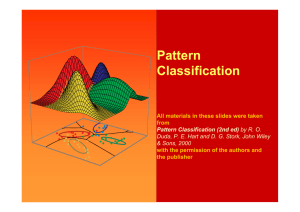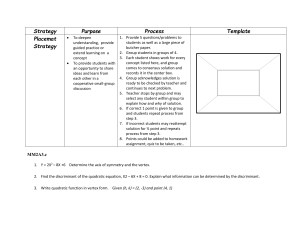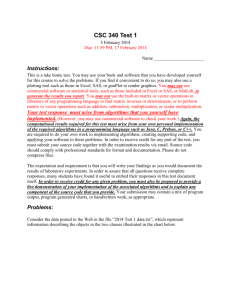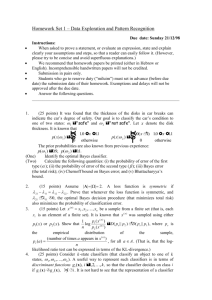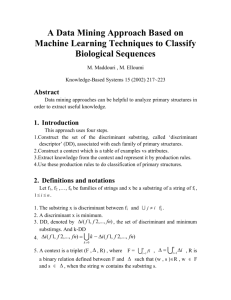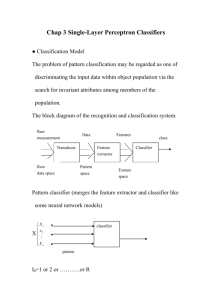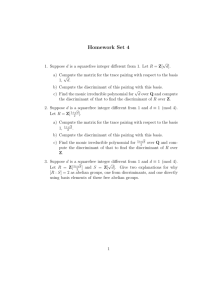Classification
advertisement
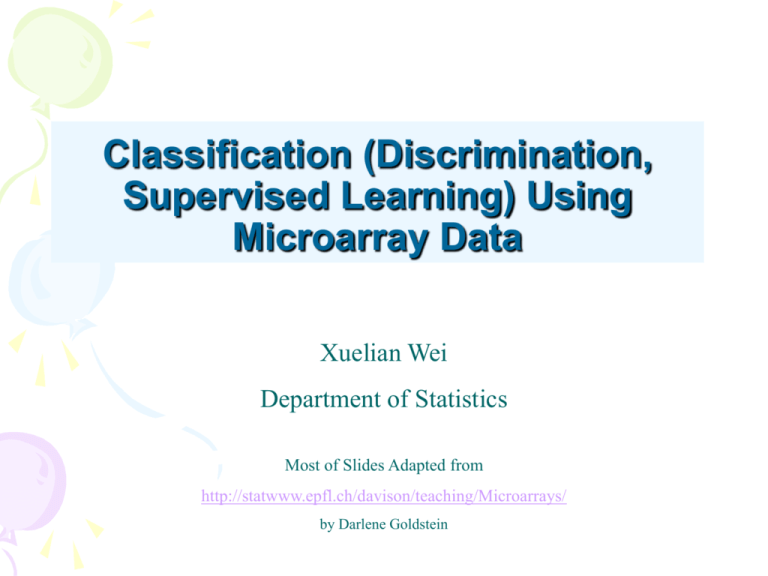
Classification (Discrimination,
Supervised Learning) Using
Microarray Data
Xuelian Wei
Department of Statistics
Most of Slides Adapted from
http://statwww.epfl.ch/davison/teaching/Microarrays/
by Darlene Goldstein
Gene expression data
mRNA samples
Normal
Normal
Normal
Cancer
Cancer
sample1 sample2 sample3 sample4 sample5 …
Genes
1
2
3
4
5
0.46
-0.10
0.15
-0.45
-0.06
0.30
0.49
0.74
-1.03
1.06
0.80
0.24
0.04
-0.79
1.35
1.51
0.06
0.10
-0.56
1.09
0.90
0.46
0.20
-0.32
-1.09
...
...
...
...
...
Gene expression level of gene i in mRNA sample j
Tumor Classification Using Gene
Expression Data
Three main types of statistical problems associated
with the microarray data:
• Identification of “marker” genes that characterize
the different tumor classes (feature or variable
selection).
• Identification of new/unknown tumor classes using
gene expression profiles (unsupervised learning –
clustering)
• Classification of sample into known classes
(supervised learning – classification)
Classification
Y
Normal
Normal
Normal
Cancer
Cancer
sample1 sample2 sample3 sample4 sample5 …
1
2
3
4
5
0.46
-0.10
0.15
-0.45
-0.06
0.30
0.49
0.74
-1.03
1.06
0.80
0.24
0.04
-0.79
1.35
X
1.51
0.06
0.10
-0.56
1.09
0.90
0.46
0.20
-0.32
-1.09
...
...
...
...
...
unknown =Y_new
New sample
0.34
0.43
-0.23
-0.91
1.23
X_new
• Each object (e.g. arrays or columns)associated with a class label (or
response) Y {1, 2, …, K} and a feature vector (vector of predictor
variables) of G measurements: X = (X1, …, XG)
• Aim: predict Y_new from X_new.
Classifiers
• A predictor or classifier partitions the space of gene
expression profiles into K disjoint subsets, A1, ..., AK, such that
for a sample with expression profile X=(X1, ...,XG) Ak the
predicted class is k.
• Classifiers are built from a learning set (LS)
L = (X1, Y1), ..., (Xn,Yn)
• Classifier C built from a learning set L:
C( . ,L): X {1,2, ... ,K}
• Predicted class for observation X:
C(X,L) = k if X is in Ak
Classification Methods
• Fisher Linear Discriminant Analysis.
• Maximum Likelihood Discriminant Rule.
–
–
–
–
Quadratic discriminant analysis (QDA).
Linear discriminant analysis (LDA, equivalent to FLDA for K=2).
Diagnal quadratic discriminant analysis (DQDA).
Diagnal linear discriminant analysis (DLDA).
• Nearest Neighbor Classification.
• Classification and Regression Tree (CART).
• Aggregating & Bagging.
Fisher Linear Discriminant Analysis
-- M.Barnard. The secular variations of skull characters in four series of egyptian skulls.
Annals of Eugenics, 6:352-371, 1935.
-- R.A.Fisher. The use of multiple measurements in taxonomic problems. Annals of
Eugenics, 7:179-188, 1936.
Fisher Linear Discriminant Analysis
• In a two-class classification problem, given n
samples in a d-dimensional feature space. n1 in
class 1 and n2 in class 2.
• Goal: to find a vector w, and project the n
samples on the axis y=w’x, so that the projected
samples are well separated.
QuickTime™ and a
TIFF (LZW) decompressor
are needed to see this picture.
Fisher Linear Discriminant Analysis
• The sample mean vector for the ith class is mi and the
sample covariance matrix for the ith class is Si.
• The between-class scatter matrix is:
SB=(m1-m2)(m1-m2)’
• The within-class scatter matrix is:
Sw= S1+S2
• The sample mean of the projected points in the ith class
is:
˜i
m
1
w' x w' mi
ni x ith class
• The variance of the projected points in the ith class is:
S˜ i
(w' x w' m )
i
x ith class
2
w' Si w
Fisher Linear Discriminant Analysis
The fisher linear discriminant
analysis will choose the w,
which maximize:
| m˜ 1 m˜ 2 |2 w' SB w
J(w)
2
2
S˜1 S˜ 2
w'Sw w
QuickTime™ and a
TIFF (LZW) decompressor
are needed to see this picture.
m˜ 1
˜2
m
i.e. the between-class distance should be as large as
possible, meanwhile the within-class scatter should be
as small as possible.
Fisher Linear Discriminant Analysis
QuickTime™ and a
TIFF (LZW) decompressor
are needed to see this picture.
For K=2, FLDA yields the same classifier as the Lear maximum likelihood
discriminant rule.
Maximum Likelihood Discriminant Rule
• A maximum likelihood classifier (ML) chooses the
class that makes the chance of the observations
the highest
• Assume the condition density for each class is
Pk (x) Pr(x | y k)
• the maximum likelihood (ML) discriminant rule
predicts the class of an observation X by that
whichgives the largest likelihood to X, i.e., by
C(X) argmax Pk (X)
k
Gaussian ML Discriminant Rules
• Assume the conditional densities for each class is a
multivariate Gaussian (normal), P(X|Y= k) ~ N(k, k),
• Then ML discriminant rule is
C(X) = argmink {(X - k) k-1 (X - k)’ + log| k |}
• In general, this is a quadratic rule (Quadratic discriminant
analysis, or QDA in R)
• In practice, population mean vectors k and covariance
matrices k are estimated from learning set L.
ˆ S
ˆ k x k and
k
k
ˆ (X
ˆ |
ˆ k )
ˆ k ) log |
C(X,L) arg min (X
k
k
k
Gaussian ML Discriminant Rules
• When all class densities have the same covariance matrix, k =
the discriminant rule is linear (Linear discriminant analysis,
or LDA in R; FLDA for k = 2):
C(X) = argmink (X - k) -1 (X - k)’
• In practice, population mean vectors k and constant
covariance matrices are estimated from learning set L.
ˆ (n 1)S /(n K)
ˆ k x k and
k
k
k
ˆ 1(X
ˆ k )
ˆ k )
C(X,L) argmin (X
k
Gaussian ML Discriminant Rules
• When the class densities have diagonal covariance matrices,
2
2
k diag( k1
,..., kG
), the discriminant rule is given by additive
quadratic contributions from each variable (Diagonal quadratic
discriminant analysis, or DQDA)
(x ) 2
2
C(x) = argmin k i 2ki log ki
ki
i1
G
• When all class densities have the same diagonal covariance
matrix =diag(12… G2), the discriminant rule is again linear
(Diagonal linear discriminant analysis, or DLDA in R)
G
C(x) = argmin
k
i1
(x i ki ) 2
i2
Application of ML discriminant
Rule
• Weighted gene voting method. (Golub et al. 1999)
– One of the first application of a ML discriminant rule to gene
expression data.
– This methods turns out to be a minor variant of the sample
Diagonal Linear Discriminant rule.
–
Golub TR, Slonim DK, Tamayo P, Huard C, Gaasenbeek M, Mesirov JP,Coller H, Loh ML,
Downing JR, Caligiuri MA, Bloomfield CD, Lander ES. (1999).Molecular classification of
cancer: class discovery and class prediction bygene expression monitoring. Science. Oct
15;286(5439):531 - 537.
Example: Weighted gene voting method
• Weighted gene voting method. (Golub et al. 1999)
When a new sample arrived, each marker gene will give a vote for either
ALL or AML depended on which class it is close to.
v i = x i (ALL,i AML,i ) /2,
w i |
ALL,i AML,i
|
ALL,i AML,i
The sums of the weighted votes (ALL and AML) become the total votes.
The sample is assigned to the class with the higher total vote,
Example: Weighted Voting method
vs Diagonal Linear discriminant rule
In the Diagonal LD rule,
we assume each class has the same diagonal covariance.
diag(12 ,..., G2 )
For two class k = ALL and AML, the Diagonal DL rule classifies an observation
x (x1,..., xG ) as class ALL iff
G
(x i - AML,i ) 2
G
i2
i=1
(x i - ALL,i ) 2
i2
i=1
,
that is, iff
G
(AML,i - ALL,i )
i=1
i2
(x i
(AML,i + ALL,i )
) 0,
2
wihch can be rewriten as
p
v
i i
0.
i=1
This is almost the same function as used in Golub
Golub et al. define as w i
et al., expcept for w i which
(AML,i - ALL,i )
ˆ AML,i ALL,i is an unusual way to
. While
ˆ AML,i ALL,i
calculate the standard error of a deffierence.
Nearest Neighbor Classification
• Based on a measure of distance between observations (e.g.
Euclidean distance or one minus correlation).
• k-nearest neighbor rule (Fix and Hodges (1951)) classifies an
observation X as follows:
– find the k closest observations in the training data,
– predict the class by majority vote, i.e. choose the class that
is most common among those k neighbors.
– k is a parameter, the value of which will be determined by
minimizing the cross-validation error later.
– E. Fix and J. Hodges. Discriminatory analysis. Nonparametric discrimination:
Consistency properties. Tech. Report 4, USAF School of Aviation Medicine,
Randolph Field, Texas, 1951.
CART: Classification Tree
BINARY RECURSIVE PARTITIONING TREE
• Binary
-- split parent node into two child nodes
• Recursive
-- each child node can be treated as parent node
• Partitioning
-- data set is partitioned into mutually exclusive subsets
in each split
-- L.Breiman, J.H. Friedman, R. Olshen, and C.J. Stone. Classification and
regression trees. The Wadsworth statistics/probability series. Wadsworth
International Group, 1984.
Classification Trees
• Binary tree structured classifiers are constructed by
repeated splits of subsets (nodes) of the measurement
space X into two descendant subsets (starting with X
itself)
• Each terminal subset is assigned a class label; the
resulting partition of X corresponds to the classifier
• RPART in R or TREE in R
Three Aspects of Tree
Construction
• Split Selection Rule
• Split-stopping Rule
• Class assignment Rule
• Different tree classifiers use different approaches
to deal with these three issues, e.g. CART(
Classification And Regression Trees)
Three Rules (CART)
• Splitting: At each node, choose split maximizing decrease
in impurity (e.g. Gini index, entropy, misclassification error).
• Split-stopping: Grow large tree, prune to obtain a
sequence of subtrees, then use cross-validation to identify
the subtree with lowest misclassification rate.
• Class assignment: For each terminal node, choose the
class with the majority vote.
CART
Comparison
• Iris Data
– Y: 3 species,
• Iris setosa (red), versicolor (green), and virginica
(blue).
– X: 4 variables
• Sepal length and width
• Petal length and width (ignored!)
Other Classifiers Include…
• Support vector machines (SVMs)
• Neural networks
• HUNDREDS more…
• The Best Reference: Google
Aggregating classifiers
• Breiman (1996, 1998) found that gains in accuracy could be
obtained by aggregating predictors built from perturbed
versions of the learning set; the multiple versions of the
predictor are aggregated by weighted voting.
• Let C(., Lb) denote the classifier built from the b-th perturbed
learning set Lb, and let wb denote the weight given to
predictions made by this classifier. The predicted class for an
observation x is given by
argmaxk ∑b wbI(C(x,Lb) = k)
-- L. Breiman. Bagging predictors. Machine Learning, 24:123-140, 1996.
-- L. Breiman. Out-of-bag eatimation. Technical report, Statistics Department, U.C. Berkeley, 1996.
-- L. Breiman. Arcing classifiers. Annals of Statistics, 26:801-824, 1998.
Aggregating Classifiers
• The key to improved accuracy is the possible
instability of the prediction method, i.e., whether
small changes in the learning set result in large
changes in the predictor.
• Unstable predictors tend to benefit the most from
aggregation.
– Classification trees (e.g.CART) tend to be unstable.
– Nearest neighbor classifier tend to be stable.
Bagging & Boosting
• Two main methods for generating
perturbed versions of the learning set.
– Bagging.
--
L. Breiman. Bagging predictors. Machine Learning, 24:123-140,
1996.
– Boosting.
-- Y.Freund and R.E.Schapire. A decision-theoretic generalization of
on-line learning and an application to boosting. Journal of computer
and system sciences, 55:119-139, 1997.
Bagging= Bootstrap aggregating
I. Nonparametric Bootstrap (BAG)
• Nonparametric Bootstrap (standard bagging).
• perturbed learning sets of the same size as the original
learning set are formed by randomly selecting samples
with replacement from the learning sets;
• Predictors are built for each perturbed dataset and
aggregated by plurality voting plurality voting (wb=1),
i.e., the “winning” class is the one being predicted by
the largest number of predictors.
Bagging= Bootstrap aggregating
II. Parametric Bootstrap (MVN)
• Parametric Bootstrap.
• Perturbed learning sets are generated according to a mixture of
multivariate normal (MVN) distributions.
• The conditional densities for each class is a multivariate Gaussian
(normal), i.e., P(X|Y= k) ~ N(k, k), the sample mean vector and
sample covariance matrix will be used to estimate the population mean
vector and covariance matrix.
• The class mixing probabilities are taken to be the class proportions in
the actual learning set.
• At least one observation be sampled from each class.
• Predictors are built for each perturbed dataset and
aggregated by plurality voting plurality voting (wb=1).
Bagging= Bootstrap aggregating
III. Convex pseudo-data (CPD)
• Convex pseudo-data. One perturbed learning set are
generated by repeating the following n times:
• Select two samples (x,y) and (x’, y’) at random form the learning set L.
• Select at random a number of v from the interval [0,d], 0<=d<=1, and
let u=1-v.
• The new sample is (x’’, y’’) where y’’=y and x’’=ux+vx’
• Note that when d=0, CPD reduces to standard bagging.
• Predictors are built for each perturbed dataset and
aggregated by plurality voting plurality voting (wb=1).
Boosting
• The perturbed learning sets are resampled adaptively so that the weights in
the re-sampling are increased for those
cases most often misclassified.
• The aggregation of predictors is done by
weighted voting (wb != 1).
Boosting
• Learning set: L = (X1, Y1), ..., (Xn,Yn)
• Re-sampling probabilities p={p1,…, pn}, initialized to be
equal.
• The bth step of the boosting algorithm is:
– Using the current re-sampling prob p, sample with replacement
from L to get a perturbed learning set Lb.
– Build a classifier C(., Lb) based on Lb.
– Run the learning set L through the classifier C(., Lb) and let di=1
if the ith case is classified incorrectly and let di=0 otherwise.
– Define b pi di and b (1 b )
i
b
pi
and update the re-sampling prob for the (b+1)st step by
pi bd i
p
j
j
• The weight for each classifier is b log( b )
dj
b
Comparison of classifiers
• Dudoit, Fridlyand, Speed (JASA, 2002)
• FLDA (Fisher Linear Discriminant Analysis)
• DLDA (Diagonal Linear Discriminant Analysis)
• DQDA (Diagonal Quantic Discriminant Analysis)
• NN (Nearest Neighbour)
• CART (Classification and Regression Tree)
• Bagging and boosting
• Bagging (Non-parametric Bootstrap )
• CPD (Convex Pseudo Data)
• MVN (Parametric Bootstrap)
• Boosting
-- Dudoit, Fridlyand, Speed: “Comparison of discrimination methods for the
Comparison study datasets
• Leukemia – Golub et al. (1999)
n = 72 samples, G = 3,571 genes
3 classes (B-cell ALL, T-cell ALL, AML)
• Lymphoma – Alizadeh et al. (2000)
n = 81 samples, G = 4,682 genes
3 classes (B-CLL, FL, DLBCL)
• NCI 60 – Ross et al. (2000)
N = 64 samples, p = 5,244 genes
8 classes
Procedure
• For each run (total 150 runs):
– 2/3 of sample randomly selected as learning set (LS),
rest 1/3 as testing set (TS).
– The top p genes with the largest BSS/WSS are
selected using the learning set.
• p=50 for lymphoma dataset.
• p=40 for leukemia dataset.
• p=30 for NCI 60 dataset.
– Predictors are constructed and error rated are
obtained by applying the predictors to the testing set.
Leukemia data, 2 classes: Test set error rates;150 LS/TS runs
Leukemia data, 3 classes: Test set error rates;150 LS/TS runs
Lymphoma data, 3 classes: Test set error rates; N=150 LS/TS runs
NCI 60 data :Test set error rates;150 LS/TS runs
Results
• In the main comparison of Dudoit et al, NN
and DLDA had the smallest error rates, FLDA
had the highest
• For the lymphoma and leukemia datasets,
increasing the number of genes to G=200
didn't greatly affect the performance of the
various classifiers; there was an improvement
for the NCI 60 dataset.
• More careful selection of a small number of
genes (10) improved the performance of
FLDA dramatically
Comparison study – Discussion (I)
• “Diagonal” LDA: ignoring correlation between
genes helped here. Unlike classification trees
and nearest neighbors, LDA is unable to take
into account gene interactions
• Although nearest neighbors are simple and
intuitive classifiers, their main limitation is that
they give very little insight into mechanisms
underlying the class distinctions
Comparison study – Discussion (II)
• Variable selection: A crude criterion such as
BSS/WSS may not identify the genes that
discriminate between all the classes and may
not reveal interactions between genes
• With larger training sets, expect improvement in
performance of aggregated classifiers
Acknowledgements
• Some of slides adapted form
http://statwww.epfl.ch/davison/teaching/
Microarrays/ by Darlene Goldstein
Thank you!
